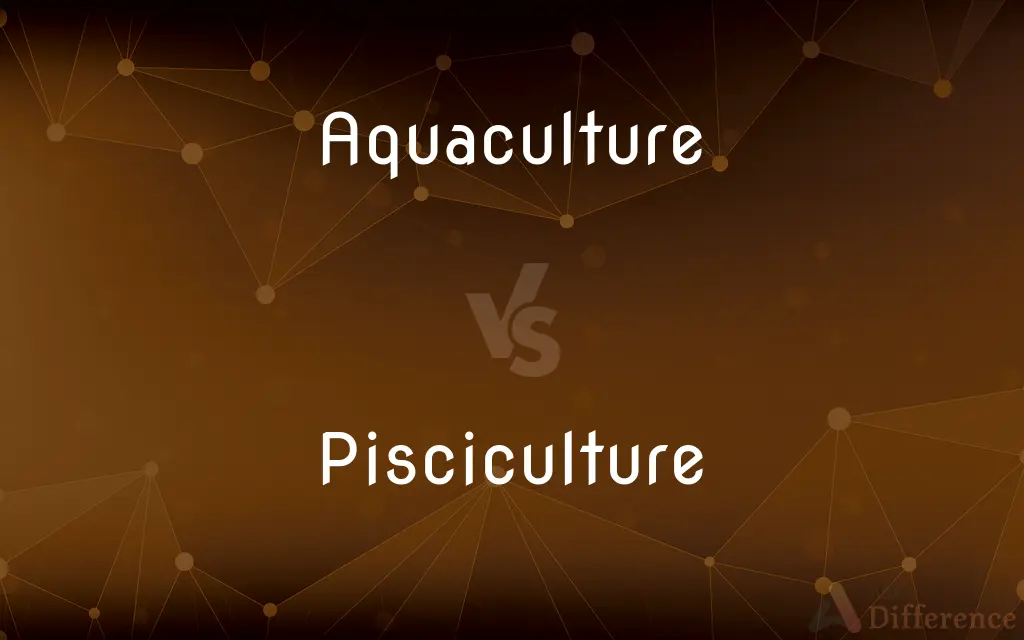Aquaculture vs. Pisciculture — What's the Difference?
By Fiza Rafique & Urooj Arif — Updated on March 20, 2024
Aquaculture encompasses the breeding and harvesting of various aquatic organisms, while pisciculture focuses solely on fish.

Difference Between Aquaculture and Pisciculture
Table of Contents
ADVERTISEMENT
Key Differences
Aquaculture is a broad term that includes the cultivation of all aquatic organisms, including fish, crustaceans, mollusks, and aquatic plants, in controlled environments. It aims at enhancing food production, restoring habitat, and building populations of endangered species. On the other hand, pisciculture is a subset of aquaculture that specifically deals with the breeding, rearing, and transplantation of fish, primarily for commercial purposes. While aquaculture covers a wide range of aquatic farming practices, pisciculture focuses exclusively on fish species, making it a more specialized field.
Aquaculture techniques can vary widely, ranging from open-ocean cages to land-based ponds, and can include a diverse array of species. This diversity allows for a broad application of aquaculture in terms of geography, economic conditions, and cultural preferences. Pisciculture, however, is mainly concerned with optimizing conditions for fish species, often involving selective breeding and specialized feed to improve yield and disease resistance.
Environmental impacts are a significant consideration in both aquaculture and pisciculture. Aquaculture's diverse practices can lead to varied environmental effects, such as habitat alteration, water pollution, and the introduction of non-native species. Pisciculture, while also subject to these concerns, particularly focuses on the implications of fish farming, like the potential for escaped fish to interbreed with wild populations, altering the genetic makeup.
Market demand and economic value also differentiate aquaculture from pisciculture. Aquaculture caters to a wide market demand, producing a range of products from luxury items like pearls and ornamental fish to staples like rice and seaweed. Pisciculture is more narrowly focused on the fish market, with significant attention to species that have high commercial value, such as salmon, trout, and carp.
Research and technological advancements play a crucial role in both fields. In aquaculture, innovations aim at sustainable practices that minimize environmental impact and improve efficiency across various species. Pisciculture benefits from these advancements but often focuses on genetic research and disease control to enhance fish productivity and health.
ADVERTISEMENT
Comparison Chart
Scope
Broad, covering all aquatic organisms
Narrow, focusing solely on fish
Practices
Includes diverse methods for various species
Concentrated on fish breeding and rearing techniques
Environmental Impact
Varied, depending on the species and methods used
Mainly concerns related to fish farming, like genetic pollution
Market Demand
Serves a wide range of demands, from food to decorative items
Primarily targets the commercial fish market
Research Focus
Sustainable practices and efficiency across species
Genetic enhancement and disease control in fish
Compare with Definitions
Aquaculture
The cultivation of aquatic organisms in controlled environments.
The aquaculture industry has seen significant growth due to increasing seafood demand.
Pisciculture
The breeding and rearing of fish under controlled conditions.
Pisciculture has become a vital part of the global food supply chain.
Aquaculture
A method for producing food and other commercial products, restoring habitats, and replenishing wild stocks.
Aquaculture contributes to habitat restoration by cultivating endangered species.
Pisciculture
A branch of aquaculture focused exclusively on fish.
Pisciculture techniques often involve selective breeding to enhance desirable traits.
Aquaculture
The science and business of breeding, raising, and harvesting aquatic organisms.
Aquaculture specialists study the best practices for raising healthy and productive aquatic species.
Pisciculture
The science of fish farming, including genetics, nutrition, and disease control.
Advances in pisciculture have led to more efficient and sustainable fish farming methods.
Aquaculture
The practice of farming fish, shellfish, algae, and other aquatic plants.
Aquaculture techniques vary widely, from high-tech tank systems to simple pond farms.
Pisciculture
An industry aimed at maximizing the yield and quality of farmed fish.
Pisciculture experts continuously seek ways to improve fish health and growth rates.
Aquaculture
An industry focused on enhancing the production of aquatic life for various purposes.
Innovations in aquaculture aim at making it more sustainable and less environmentally impactful.
Pisciculture
The practice of growing fish for commercial purposes, including food production and stocking water bodies.
Pisciculture operations range from small ponds to large-scale commercial farms.
Aquaculture
Aquaculture (less commonly spelled aquiculture), also known as aquafarming, is the controlled cultivation ("farming") of aquatic organisms such as fish, crustaceans, mollusks, algae and other organisms of value such as aquatic plants (e.g. lotus).
Pisciculture
The breeding, hatching, and rearing of fish under controlled conditions.
Aquaculture
The cultivation of marine or freshwater organisms, especially food fish or shellfish such as salmon or oysters, under controlled conditions. Also called aquafarming.
Pisciculture
The rearing or cultivation of fish.
Aquaculture
The cultivation of aquatic produce such as aquatic plants, fish, and other aquatic animals.
Pisciculture
Fish culture. See under Fish.
Aquaculture
The cultivation of aquatic animals, such as fish or shellfish, or of plants, such as seaweed, in a controlled and sometimes enclosed body of water. The term includes use of either salt or fresh water. It is a form of agriculture, but under water.
Aquaculture
Rearing aquatic animals or cultivating aquatic plants for food
Common Curiosities
What are some common practices in aquaculture?
Aquaculture practices include pond farming, cage farming, and tank farming, catering to a wide range of aquatic species.
Why is pisciculture important?
Pisciculture plays a crucial role in food security, providing a sustainable source of protein and supporting livelihoods.
How does aquaculture contribute to biodiversity conservation?
Aquaculture can contribute to biodiversity conservation by replenishing endangered species and restoring habitats.
What is aquaculture?
Aquaculture is the farming of aquatic organisms, including fish, crustaceans, mollusks, and aquatic plants, in controlled environments.
How does pisciculture differ from aquaculture?
Pisciculture is a subset of aquaculture focused solely on the breeding and rearing of fish.
Can aquaculture have negative environmental impacts?
Yes, aquaculture can lead to habitat destruction, water pollution, and the introduction of invasive species if not managed sustainably.
Can aquaculture practices vary by region?
Yes, aquaculture practices often vary by region, influenced by local ecological conditions, cultural preferences, and economic factors.
What research is being done in aquaculture?
Research in aquaculture focuses on improving efficiency, sustainability, and disease resistance across various species.
What types of fish are commonly farmed in pisciculture?
Commonly farmed fish include salmon, trout, tilapia, and carp, chosen for their market demand and adaptability to farming conditions.
Is aquaculture sustainable?
Aquaculture can be sustainable if practices minimize environmental impact, promote biodiversity, and use resources efficiently.
What are some challenges facing pisciculture?
Challenges in pisciculture include disease management, genetic pollution, and the need for sustainable feed sources.
What role does pisciculture play in global food production?
Pisciculture is vital for global food production, providing a significant portion of the world's fish consumption.
How does pisciculture benefit the economy?
Pisciculture generates income, supports livelihoods, and contributes to food security, playing a significant role in local and global economies.
What innovations are improving pisciculture?
Innovations in pisciculture include genetic selection, automated feeding systems, and environmentally friendly disease control methods.
How are aquaculture and pisciculture regulated?
Aquaculture and pisciculture are regulated by national and international standards to ensure environmental sustainability, animal welfare, and food safety.
Share Your Discovery

Previous Comparison
Morula vs. Blastula
Next Comparison
Slumber vs. SleepAuthor Spotlight
Written by
Fiza RafiqueFiza Rafique is a skilled content writer at AskDifference.com, where she meticulously refines and enhances written pieces. Drawing from her vast editorial expertise, Fiza ensures clarity, accuracy, and precision in every article. Passionate about language, she continually seeks to elevate the quality of content for readers worldwide.
Co-written by
Urooj ArifUrooj is a skilled content writer at Ask Difference, known for her exceptional ability to simplify complex topics into engaging and informative content. With a passion for research and a flair for clear, concise writing, she consistently delivers articles that resonate with our diverse audience.














































